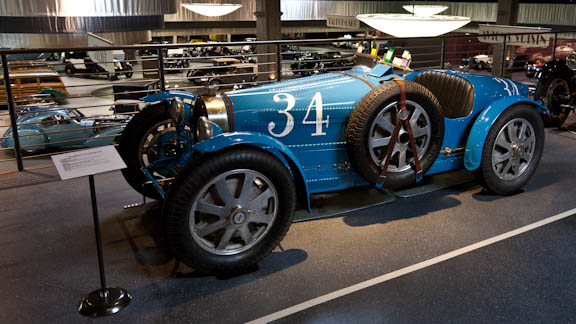Meanwhile, back at the Mullin Automobile Museum, when talking about cars as Art, the two names the raise to the top of any list are Ferrari and Bugatti. Today, Ferrari is much more famous and anybody who loves cars, especially anybody who loves race cars, has a favorite Ferrari. Mine is thge 250 Testarosa. 250 Redhead.
Named redhead for the red painted red cam covers – talk about Euro-trash – I love it. It had six Weber downdraught carburetors and four megaphone shaped exhaust pipes – the sound of it's twelve cylinder engine @ 8,000 rpm has been compared to the sound of canvas tearing (OK, by Ferrari himself, true, but still) – and very bad brakes that Ferrari thought would be as good as his British competitors if only the brakes had enough cooling, thus the pontoon fenders that make it so lovely. One sold for $12.2 million in 2009.

But Ferrari – el commodore, himself, who couldn't bear to go to races lest he see his beloved cars get hurt – was an heartless industrialist compared to Ettore Bugatti, La Patron. His art pieces were built in a private compound that La Patron toured daily on his specially designed bike . He built Bugs that ranged in size from – literally, as Joe B. would say – a peddle car for his kids to a limo for kings, called the Royale, with a wheelbase of 169+ inches (for comparison the huge mid-60s Cadillac had a wheelbase of 129.5 inches) and a radiator cap featuring an elephant standing on its hindlegs. .
All Bugattis, even the Royales, were light, agile, and very fast. Fast for their time, and, most of them, just fast. A 1931 Type51 Bugatti race car – not this one which is a 1924 Type 35, but a similar one and they were almost all similar with a distinctive Bugatti look – could hit 140 miles per hour. In a car without seatbelts or a roll bar.

Bugatti is now owned by Volkswagen and the Bugatti Veyron is the fastest production car in the world at 268 mph but it is not a real Bugatti in that it was not made by La Patron and, in this museum, it is relegated to a dark corner by an exit.

Meanwhile, the center piece of the collection – the holiest of the holies – is the late 1930s Type 57C – C meaning compressor or what we now call a supercharger – which is reputed to have sold, recently, for somewhere between $30,000,000 to $40,000,000.The cars – and there were only three made – were designed by Ettore Bugatti's son, Jean. They featured a straight eight cylinder, supercharged engine, and had riveted seams that gave it a distinctive look.
(The first and last pictures are double clickable to enlarge.)




As Malcolm and I stood watching the car rotate on its special turntable we took on the same quiet awe as everybody else. There are side reasons for that awe: the car is restored way past the level with which it left the factory; it sits in the center of the museum among similar but lesser wonders; it is the center of attention; but, for me, it is the artifact-ness of it that most captivates me. It is the distillation of one man's vision.
Building a car is a team effort, but only when that effort is in service to one person's vision does it transcend an automobile as an appliance and become a work of art.
Like this:
Like Loading...